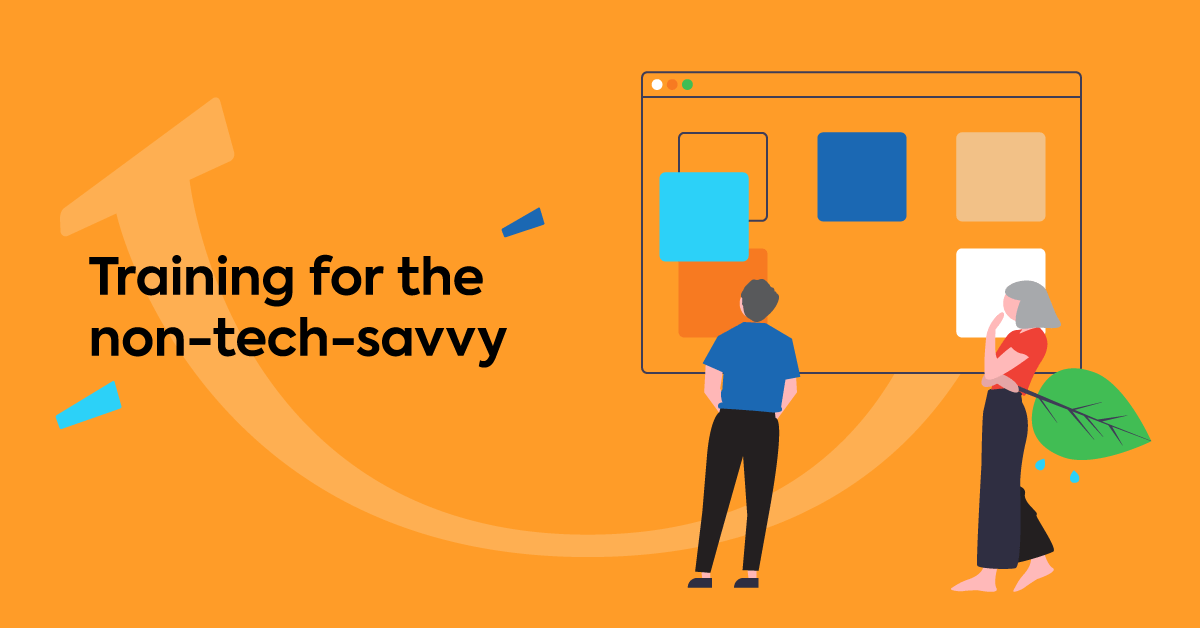Nobody gets into business, HR, or L&D because they dream of chasing down training certificates or manually updating spreadsheets with employee progress.
But let’s face it, without the right tools, we end up spending more time on administrative headaches than on actual employee development.
Think about it. How many times have you had to…
- Scramble to find the latest version of that onboarding manual?
- Send email reminders to employees about mandatory compliance training courses (and then follow up with the ones who “forgot”)?
- Cobble together reports for your CEO on training completion rates using data scattered across multiple platforms?
This chaos is the reality for many organizations without a learning management system (LMS).
And it’s the answer to many HR and L&D headaches, benefitting the company, the employees and the customers.
The question is, how do you get approval on an LMS? Well, with an LMS business case.
We’ll give you all the tools you need to make a strong LMS business case, along with templates you can use to get the ‘yes’ from multiple stakeholders.
Why do you need an LMS business case?
As much as you might be convinced that an LMS is the solution to your training troubles, the reality is that most decision-makers aren’t going to hand over a chunk of the budget just because you think an LMS can help.
They need to see the value, the training return on investment (ROI), and how it aligns with the company’s overall goals. To do this, you need to speak their language. Something that you can do with an LMS business case (aka a plan of attack).
Using an LMS business case, you can prove that the LMS is a smart investment that will help you:
- Save the company money. Yes, an LMS has upfront costs, but it can significantly reduce expenses in the long run.
- Manage training. Many learning management systems can automate tasks, centralize resources (in one learning system!), and check that everyone meets regulatory requirements.
- Improve employee productivity. An LMS can give employees personalized learning experiences, track their progress, and find skills gaps. This helps them work better and do more.
- Improve employee retention. An LMS can provide a platform for continuous development, making employees feel valued and invested in, leading to higher engagement and reduced turnover.
- Create better training reports (in less time). An LMS gives you the power to track progress, identify trends, and prove the impact of your training programs – all with a few clicks.
Creating a business case (or an LMS business case) can be a bit daunting. But, in the business world, you need to ensure that every decision aligns with business needs.
How to create a business case for an LMS
Forget wishy-washy pleas for a “better training system”, to get your LMS budget approved, you need a persuasive business case and demonstrate that you’ve done your due diligence.
Describe what the problem is
Before you prescribe the solution, you need to prove a clear and present need.
Instead of simply listing the problems, why not make it more informative and thought-provoking by writing the problems as questions and then giving them data to back up your problems?
This way, the reader can visualize the benefits and the statistics:
- “New hires can hit the ground running in weeks, not months.” (Then, back it up with data on current onboarding times and the cost of delayed productivity.)
- “What if we could track the impact of every training dollar spent?” (Follow up with the current expenditure on external training and the lack of measurable outcomes.)
Discuss the proposed solution
With the problems now identified, you can prescribe the cure: an LMS.
But don’t just list the features of an LMS, showcase solutions to your previous problems backed by evidence.
Here’s how we can apply that to the first problem we laid out before.
“Faster onboarding and more productive new hires.” Then share statistics on how LMS-driven onboarding programs reduce ramp-up time by X% (cite industry benchmarks or case studies). Also, explain how features like automated enrollment, interactive modules, and progress tracking accelerate learning and boost new hire satisfaction and productivity.
Showcase top contenders & shortlist features
After you’ve prescribed the solution, you’ll want to list the LMS or (LMSs) you chose in your business case, along with the shortlisted features for each one.
Clearly state your selections. For example, “Based on our needs, our top contender is: TalentLMS.” And provide an overview of other contenders on your list. Also, offer a concise summary of each LMS, highlighting its strengths and areas of expertise.
Lastly, list the features that each one has that are most relevant to your organization’s needs and goals. For example, if an AI course creator is crucial, and one of the LMSs has it, then mention that.
Consider costs and budget
When it comes to investing in an LMS, it’s a good idea to be clear-eyed about the costs involved.
The initial cost of the LMS is just the starting point. You’ll need to factor in LMS implementation fees, ongoing maintenance, support costs, and potential upgrades over the expected lifespan of the LMS.
Be realistic about what your organization can afford (even if you don’t have all the financial or budget information). Try not to overspend, but don’t skimp either.
Show estimated ROI
While you may not be able to provide a precise ROI calculation, you can still paint a compelling picture of the long-term business value an LMS can bring to your organization.
At a high level, you should:
- Collect data on your current training costs, employee turnover rates, and productivity metrics and use that as a baseline for comparison.
- Then, estimate potential savings & profit. How much will the LMS reduce your training costs? How will it improve customer retention and employee development? How will it possibly affect the overall bottom line? Use industry benchmarks and case studies to support your estimates.
- Don’t forget to point out the intangible benefits. An LMS can boost morale, improve engagement, and give employees a sense of growth and motivation.
You can also use visuals to your advantage. People engage and understand charts, graphs, and infographics much easier than numbers on pages.
Plan the LMS implementation
While you’re building your business case, it’s also helpful to show you’ve thought ahead about how you’ll actually roll this out to your team. This demonstrates that you’re not just throwing software at the problem, but that you’re committed to making it a success.
Consider a pilot program where you introduce the LMS to a smaller group first. This way, you can gather feedback, iron out any wrinkles, and refine your approach before a wider launch.
If you’re confident in your plan and ready to go big, a simultaneous rollout to the entire organization can generate excitement and create a unified learning experience.
How to choose an LMS
Before you dive head-first into the LMS selection process (we’ll get to that later), take a moment to define your non-negotiables. This will help you narrow down your options and focus on features that truly matter to your organization.
Once you’ve done this and whittled down your chosen LMSs you can work through this list.
Target audience
It all starts with getting clear about who will be using this LMS. Knowing who will use it and what their preferences and learning styles are will help you choose an LMS that caters to them.
For example, say you’re a healthcare organization. Your target audience might include nurses needing recertification credits, administrative staff learning new software, and patients accessing training materials. Or you may need customer training for your software. You’d need an LMS that can handle diverse content formats, track certifications, and not one about learning new sales skills.
A few questions you can use to help you understand your audience better:
- Who are your learners? Are they employees, customers, partners, or a mix of all three?
- What are their learning goals? Do they need to master specific skills, stay up-to-date on industry regulations, or develop leadership qualities?
- What’s their tech-savviness level?
Features & capabilities
Next, let’s talk about learning management system features, as all are not made equal.
Simply put, you wouldn’t want a cramped cottage with leaky ceilings when you could have a spacious mansion with all the bells and whistles, right? The same thing applies to an LMS.
With that in mind, let’s go over what features and capabilities you should look for to present in your LMS business case.
First things first, you need a learning management system that lets you effortlessly add, create, and curate content (aka training materials). From snappy videos and interactive quizzes to classic documents and presentations, you want a system that can handle it all.
Next up is ease of use, because nobody wants to wrestle with an LMS that feels like rocket science. You need an interface that’s so intuitive even your least tech-savvy employee can navigate it with ease.
Lastly, let’s talk about data. A good LMS should give you valuable insights into your training programs. It should give you detailed reports on learner progress, engagement levels, and even areas where people might be struggling.
Training requirements
If you haven’t already, then you’ll need to map out your training needs with a training needs analysis. They will tell you how often you’ll be training, how many learners you’ll have, and whether your needs change throughout the year.
Choose an LMS that offers the flexibility to accommodate your unique rhythm.
Potential for scalability
Choosing an LMS is a long-term investment. Ensure yours can grow with your organization and not get in the way when it happens.
Key features of a scalable LMS:
- Cloud-based. Handles fluctuations in demand and offers greater flexibility.
- Integration-friendly. Works nicely with your existing HR systems and tools.
- Robust infrastructure. Reliable servers, ample storage, and top-notch security for future growth.
Compliant software
A compliant LMS protects your organization from legal and security risks while making learning accessible to all learners.
To avoid any data breaches, you need an LMS that takes data security seriously and complies with relevant regulations, such as GDPR, CCPA, and HIPAA. Look for features like data encryption, access controls, and regular security audits to ensure your sensitive information stays safe and sound.
Live LMS demo
Once you’ve considered these factors, it’s time to see your top contenders in action. The best way to get a feel for an LMS is to experience it firsthand with a live demo.
Prioritize your demos according to your shortlist. For example, if your top contender is TalentLMS, book a demo to see it in action, ask questions, and discover how it can transform your training programs.
Identify stakeholders and pitch the LMS business case
You’ve done the hard work, built a solid business case, and you’re ready to start implementing your LMS. But before you hit “send” on that email, consider your audience.
This is because different stakeholders and decision makers care about different things.
Take, for example, the head of L&D or the head of HR. They likely care more about tools that lighten the daily struggles of employee training and about helping their employees thrive. For them, you’ll want to focus on how the LMS will make their lives easier and their training programs more effective.
On the other hand, the CEO (and most C-suites) typically wants to see the big picture. Show how the LMS will help the company crush its goals, keep employees happy, and boost that bottom line.
Remember, stakeholders are busy people. They don’t have time to wade through pages of research. Your business case needs to be clear, concise, and compelling.
To help you craft the perfect pitch, we’ve created an LMS business case template and email:
- [LMS Business Case Presentation Deck] — Your very own LMS business case example.
- [LMS Business Case Email Template] — Ready-made email template to get the conversation started.
All set to transform your training
Building an LMS business case is about more than just ticking boxes. It’s about painting a vision of a future where learning is easy, engaging, and truly drives your organization forward.
This guide has given you the steps, but you know your company best. Use those insider insights to really sell the benefits of your chosen learning management system—whether it’s saving time, boosting those training results, or just making learning more fun and engaging for everyone.
Ready to take the next step?
Sign up free to TalentLMS and see how its AI-powered features can bring your learning vision to life.
| Tags: LMS features,LMS Implementation,Template





